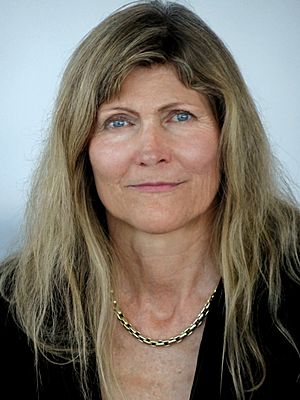Ingeborg Hochmair facts for kids
Quick facts for kids
Ingeborg J. Hochmair-Desoyer
|
|
|---|---|
 |
|
| Born | 1953 Vienna, Austria
|
| Occupation | MED-EL |
| Spouse(s) | Erwin Hochmair |
| Awards | Lasker-DeBakey Clinical Medical Research Award (2013) |
| Scientific career | |
| Fields | Electrical engineering |
| Institutions | MED-EL |
Ingeborg J. Hochmair-Desoyer (born in 1953) is an amazing Austrian electrical engineer. She is the CEO and CTO of MED-EL, a company that makes hearing implants. Dr. Hochmair and her husband, Professor Erwin Hochmair, created the world's first tiny, multi-channel cochlear implant. This invention helps many people hear better. She has won important awards for her work, including the Lasker-DeBakey Clinical Medical Research Award in 2013. She also received the 2015 Russ Prize for bioengineering.
In 1989, she helped start the medical device company MED-EL.
Contents
Biography of Ingeborg Hochmair
Ingeborg Hochmair was born in 1953 in Vienna, Austria. Her family was very smart! Her mother was a physicist. Her father was a dean at the Vienna University of Technology. Even her grandmother was one of Austria's first female chemical engineers.
Ingeborg started studying electrical engineering in 1971. In 1975, she made history. She became the first woman in Austria to earn a PhD in electrical engineering. Her special project was about how to make a system that could send electrical signals to the ear's hearing nerve.
From 1976 to 1986, she worked as a professor at the Technical University of Vienna. She also taught at Stanford University in 1979. In 1986, she moved to Innsbruck. There, she taught at the University of Innsbruck until 1989.
In 1989, Ingeborg Hochmair and her husband, Erwin Hochmair, started the hearing implant company MED-EL. She is still the main leader of the company today.
Outside of MED-EL, Ingeborg supports new research in science and technology. In 2012, she helped create a special professorship at the University of Innsbruck. This helps support female researchers in science and technology.
How Cochlear Implants Work
In 1975, Ingeborg and Erwin Hochmair began working on the cochlear implant. Their goal was to help people not just hear sounds, but also understand speech. They developed the world's first tiny, multi-channel cochlear implant.
This implant had a long, flexible wire called an electrode. It could send electrical signals to the hearing nerve along a large part of the cochlea. The cochlea is the snail-shaped part of your inner ear. Before this, other implants only used one channel.
The new multi-channel device was first used in December 1977. In 1979, a changed version of this device helped a woman understand words and sentences. She could do this without reading lips, using a small sound processor. This was a huge step for modern cochlear implants. It was one of the first times a device could truly replace a human sense.
Innovations in Hearing Technology
Through MED-EL, Dr. Hochmair has led many new discoveries in hearing implants. In 1991, they introduced a sound processor that fits behind the ear. They also created new ways for the implant to process sound. They are even working on a totally implantable cochlear implant. This means the whole device would be inside the body.
Dr. Hochmair has over 40 patents for parts of her cochlear implant. A patent protects an invention. Many of her patents are for improved versions of older parts. This shows she keeps making her device better.
Here are a few examples of her patents:
- 1999 Structure and method for an implanted hearing device
- 2003 Implantable device with flexible connection
- 2007 Tinnitus Suppressing Cochlear Implant
- 2009 Demagnetized Implant for Magnetic Resonance Imaging
- 2015 Cochlear Implant Electrode Insertion Support Device
- 2022 MRI-Safe and Force-Optimized Implantable Ring Magnet System
Dr. Hochmair has been a big part of all these patents. The cochlear implant project was her main focus. As of 2015, more than 400,000 people around the world were using her device. She continues to improve it even now.
Awards and Honours
Ingeborg Hochmair has received many awards for her important work:
- 1977 Best Paper Award, European Solid State Circuits Conference
- 1981 Holzer Prize, Technical University of Vienna
- 1995 Business Woman of the Year Award (Prix Veuve Clicquot)
- 1996 Wilhelm Exner Medal
- 2004 Honorary Doctorate in Medicine, Technical University of Munich
- 2008 Medal of Honour, State of Tyrol
- 2010 Honorary Doctorate, Medical University of Innsbruck
- 2013 Lasker-DeBakey Clinical Medical Research Award, New York, USA
- 2015 Fritz J. and Dolores H. Russ Prize, US National Academy of Engineering
- 2015 Johann Joseph Ritter von Prechtl Medal, Technical University of Vienna
- 2018 Honorary Member of the Austrian Academy of Sciences
- 2020 Honorary Doctorate, University of Uppsala
- 2021 Honorary Doctorate in Science, University of Innsbruck
Personal Life
Ingeborg Hochmair is married to her husband and business partner, Erwin Hochmair. They have four children together.
See also
 In Spanish: Ingeborg Hochmair para niños
In Spanish: Ingeborg Hochmair para niños

